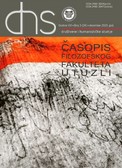THE KATABASIS TROPE AND A DESCENT INTO FUTURE IN MARGARET ATWOOD’S THE HANDMAID’S TALE
THE KATABASIS TROPE AND A DESCENT INTO FUTURE IN MARGARET ATWOOD’S THE HANDMAID’S TALE
Author(s): Milena M. Kaličanin, Marija NešićSubject(s): Gender Studies, Other Language Literature, Theory of Literature
Published by: Filozofski fakultet Univerziteta u Tuzli
Keywords: katabasis; katabatic trope; descent narrative; female identity; carnivalization;
Summary/Abstract: Katabasis represents a narrative trope which refers to the hero’s journey into the underworld, a descent into the realm of the dead, and whose presence can be found across the world, from ancient mythologies to contemporary literature. The aim of this paper is to point to the possibility of reading Margaret Atwood’s The Handmaid’s Tale as a katabatic narrative, more precisely as a variation of the archetypal hero’s journey into the underworld, where, instead of the land of the past, the descent is directed towards a dystopian future and where, instead of a mythical superhero, the protagonist is a modern-day heroine. Having already tackled the subject of Western capitalism governed by patriarchal power relations, its obsession with controlling nature, especially the process of reproduction, and the ensuing feminist descent from it, in The Handmaid’s Tale Atwood adjusts and adapts the dynamic topos of the katabasis so as to suit the contemporary reality and modern traumas. She presents a female narrator, a superheroine, trapped within the boundaries of a claustrophobic world, where women live subjugated and segregated by the oppressive male regime. Following the generic features of the term katabasis, the paper analyses the katabatic experience of Offred in the Republic of Gilead, a topos of Hell in not such a distant future, where the past has been erased and the citizens, especially the female ones, have been denied any right to identity and individuality. As there are numerous instances of carnivalesque elements, it is possible to approach the community of Gilead from the perspective of the carnivalization of the katabasis, both in the way it was defined by Mikhail Bakhtin and in a modern rendition explained by Linda Hutcheon, i.e. both a positive and an ironizing version of the concept.
Journal: DHS-Društvene i humanističke studije: časopis Filozofskog fakulteta u Tuzli
- Issue Year: XXIV/2023
- Issue No: 24
- Page Range: 279-294
- Page Count: 16
- Language: English

